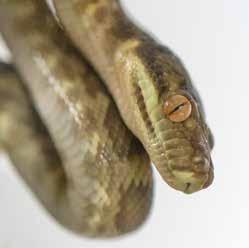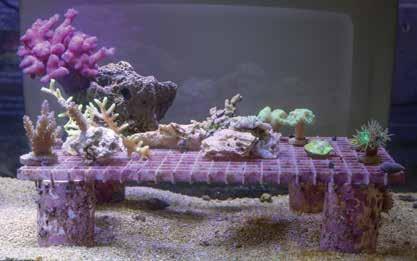
2 minute read
Behind the Scales: Aquatic & Reptile Center
The Aquatic & Reptile Center (ARC) has the most animals out of any area at the Milwaukee County Zoo. Fish alone make up more than half the total number of animals at the Zoo at about 1,300. But you might not know the ARC has hundreds of animals behind the scenes. Some of these animals are in quarantine before they can be introduced to their exhibit mates. Others, like its two arapaima fish, have to wait until they grow large enough that they won’t be eaten by other fish in the exhibit. Still others are kept in an area dedicated to education classes and behind-the-scenes tours. Here’s a peek at some of those animals and areas you won’t find on display — at least not yet. Photos by Bob Wickland


The degeni cichlid is extinct in its natural habitat of Lake Victoria, a great lake that extends into Uganda, Kenya and Tanzania. About half of the genetic stock, or 70 fish, are behind the scenes at the ARC, while the other half are found at the San Antonio Zoo. Many cichlid species in Lake Victoria are endangered or extinct due to the introduction of Nile perch, which outcompetes the cichlids for food. >>
Zookeeper Craig Pavlik target-trains a young arapaima above the Amazon flooded forest exhibit. The Zoo has two young arapaimas, and each is trained to respond to a specific target for feeding. These fish will eventually grow to be up to 10 feet long. For now they live in a separated area above the exhibit until they get large enough to defend themselves among the other fish. >>

The fantastic leaf-tailed gecko, also known as the satanic leaftailed gecko, looks just like a shriveled-up leaf in the rainforests of its Madagascar home. The Zoo acquired two of them in 2019 and plans to put them on exhibit soon. >>




Halmahera python

Shawn Miller, ARC curator, and the rest of the ARC staff have been cultivating saltwater reef aquariums behind the scenes. Reefs around the world are dying because of pollution and climate change. >>
The coral reef tanks house Indo-Australian fish such as clownfish and melanurus wrasse. All melanurus wrasse start out as female, but this fish is transitioning to male. >>


Melanurus wrasse Clownfish








